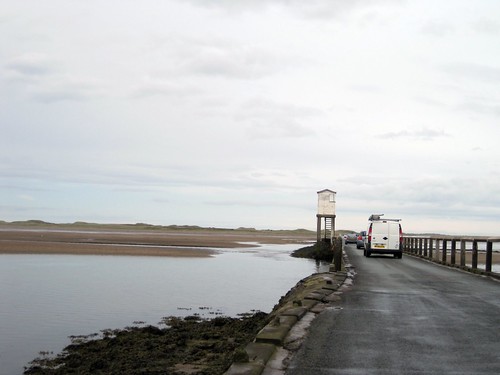
Way up off the coast of northern England just shy of the Scottish border is a special place called Holy Island. It is only accessible from the mainland during low tide, when the North Sea recedes enough to expose the Lindisfarne Causeway and allow cars and hikers to pass. The white box on stilts is actually there as a water shelter in the event that anyone gets stuck in the middle of the causeway as the tide comes in. I think this is mostly a concern for hikers in the event that they underestimate how long it will take them to cross the causeway as the tide comes in. And btw, there's no coast guard to come rescue you; you stay put until the tide goes out again.
A little over 150 people make their home on the island in one village, mostly employed in the tourist trade/hospitality. The island is known as a spiritual retreat, but its main tourist draws are Lindisfarne Priory and Lindisfarne Castle.

The castle was built in the 16th century (so quite late) and served largely as a fort in an area long held in contention between the Scots, the English and earlier, the Vikings. The modern castle was largely remodeled in the early 1900s to serve as basically a grand country manor. It is located on the highest point of the island, about a mile away from the village/priory, but a bus service runs every quarter hour between the two if you don't feel like making the hike.
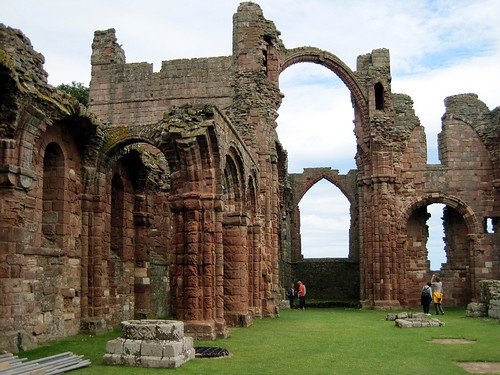
But the real draw, I think, is Lindisfarne Priory. Lindisfarne is one of the oldest Christian establishments in England, founded around 635 by St Aiden, an Irish missionary monk from Iona (a monastery in Scotland also established by Irish missionaries) who established a community on the remote island, which became the center of conversion for northern England. In the 700s, Lindisfarne was a flourishing text-production centre, producing high quality manuscripts, the most famous of which is the Lindisfarne Gospels, now on display in the British Library.
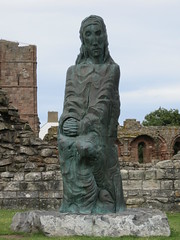 St Cuthbert, perhaps the most famous of the medieval English saints, was a monk, abbot and bishop (not at the same time!) of Lindisfarne, but his relics are now resting in Durham Cathedral as a result of the community of monks fleeing the island in the wake of a Viking attack in 875. An earlier Viking attack in 793 was the first major Viking raid in England and caused quite a bit of consternation and fear among contemporaries, even on the Continent. Monasteries were an attractive target for the Vikings because the monks generally couldn't put up much of a fight, and the monasteries were rich with treasures- golden chalices, rich tapestries, various jewel-encrusted treasures, etc. And in the days before banks, wealthy lay people often entrusted their wealth to the religious houses for safekeeping.
St Cuthbert, perhaps the most famous of the medieval English saints, was a monk, abbot and bishop (not at the same time!) of Lindisfarne, but his relics are now resting in Durham Cathedral as a result of the community of monks fleeing the island in the wake of a Viking attack in 875. An earlier Viking attack in 793 was the first major Viking raid in England and caused quite a bit of consternation and fear among contemporaries, even on the Continent. Monasteries were an attractive target for the Vikings because the monks generally couldn't put up much of a fight, and the monasteries were rich with treasures- golden chalices, rich tapestries, various jewel-encrusted treasures, etc. And in the days before banks, wealthy lay people often entrusted their wealth to the religious houses for safekeeping. So speaking of Vikings, after 805, the monastery was basically abandoned, since the community had fled with Cuthbert's relics and eventually settled in Durham. After the Norman Conquest, religious life was reintroduced to the island and a priory under the authority of Durham was founded. The ruins you see today date to this period of religious life. The priory also has a fantastic visitors centre display, well worth checking out before you make your way out to the priory itself.
But I think my favorite part when I visited was St Cuthbert's Isle. Now, you have to time it right to actually be able to get to it. St Cuthbert's is located just off the shore of Holy Isle and is only reachable during the very lowest part of low tide, but we lucked out. You have to bounce from rock to rock, trying to avoid the large puddles left by the receding sea, and you'll probably end up crushing a fair few shell-dwellers clinging to the rocks in the process (oops), but so worth it.
Cuthbert's Isle is little more than a big rocky outcrop marked with the above simple wooden cross. It is thought that this is one of the small islands near Lindisfarne that Cuthbert retreated to in order to live as a hermit before he was dragged back to become Bishop of Lindisfarne. And I can honestly say there is something incredibly powerful about the place. On a clear day like we had, there is just rocks and sea and sky blending together with the mainland far off in the distance and the wind whistling across the sea. Perfect for meditation and contemplation.
You can do the major tourist sights in a day or a very busy afternoon, but the next time I go back (and there will be a next time by golly!), I'd try to stay at least one night to really have time to enjoy the quiet and solitude and the natural beauty which drew the early Christians to Lindisfarne in the first place.

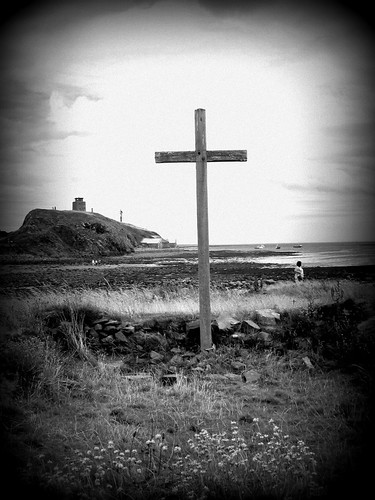
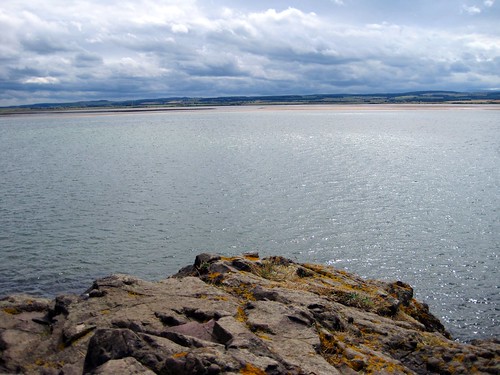

I spent a week on Holy Island in May and can vouch for the qualities of the place that you mention. It's even better at high tide when all the visitors go!
ReplyDeleteStay a week and visit the sands on the north shore!